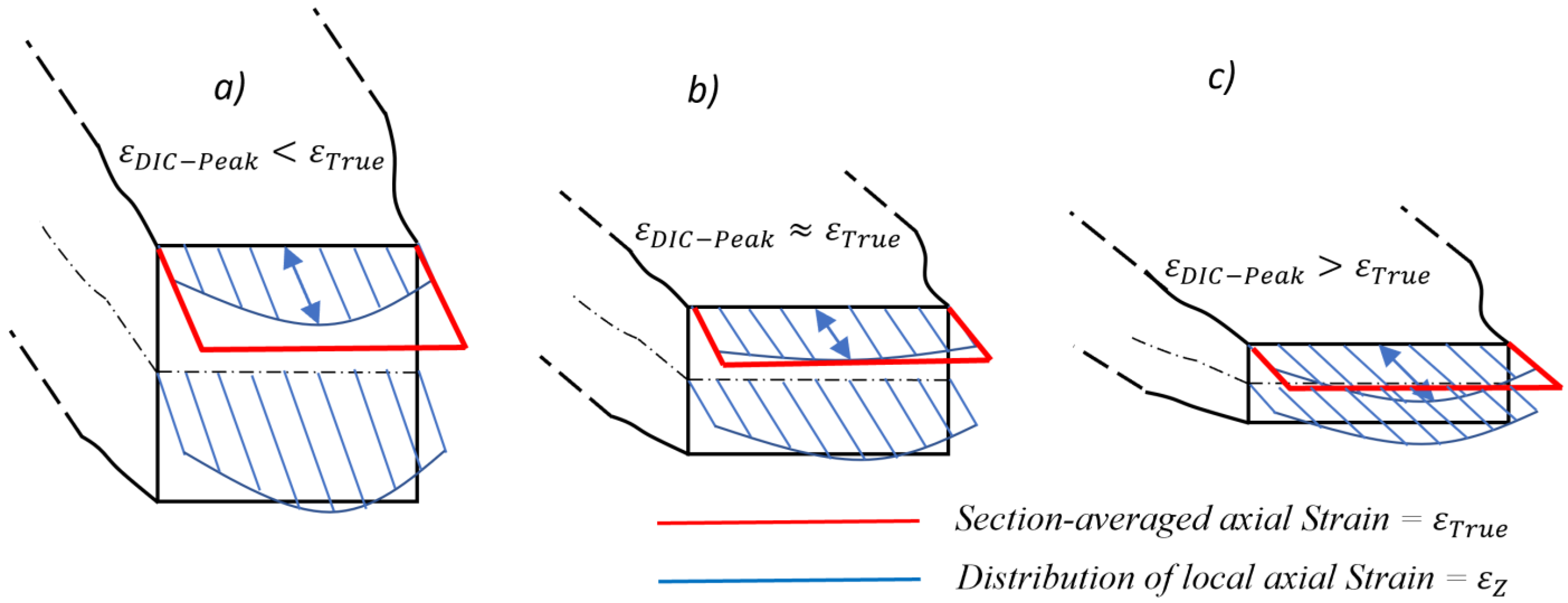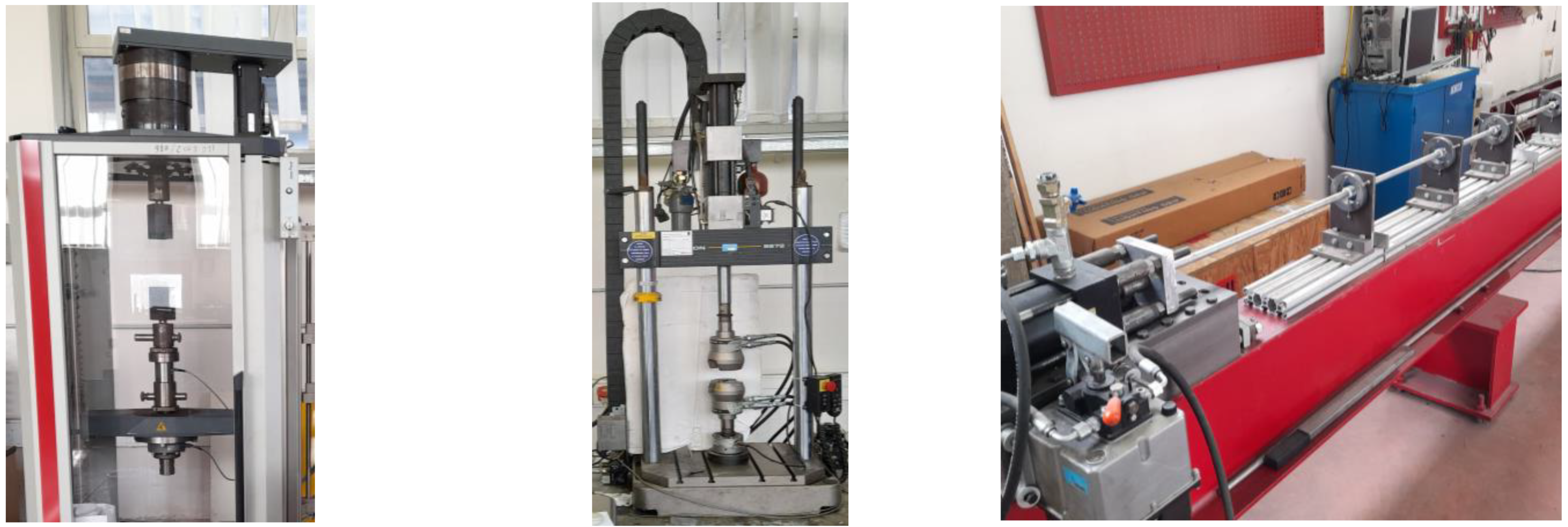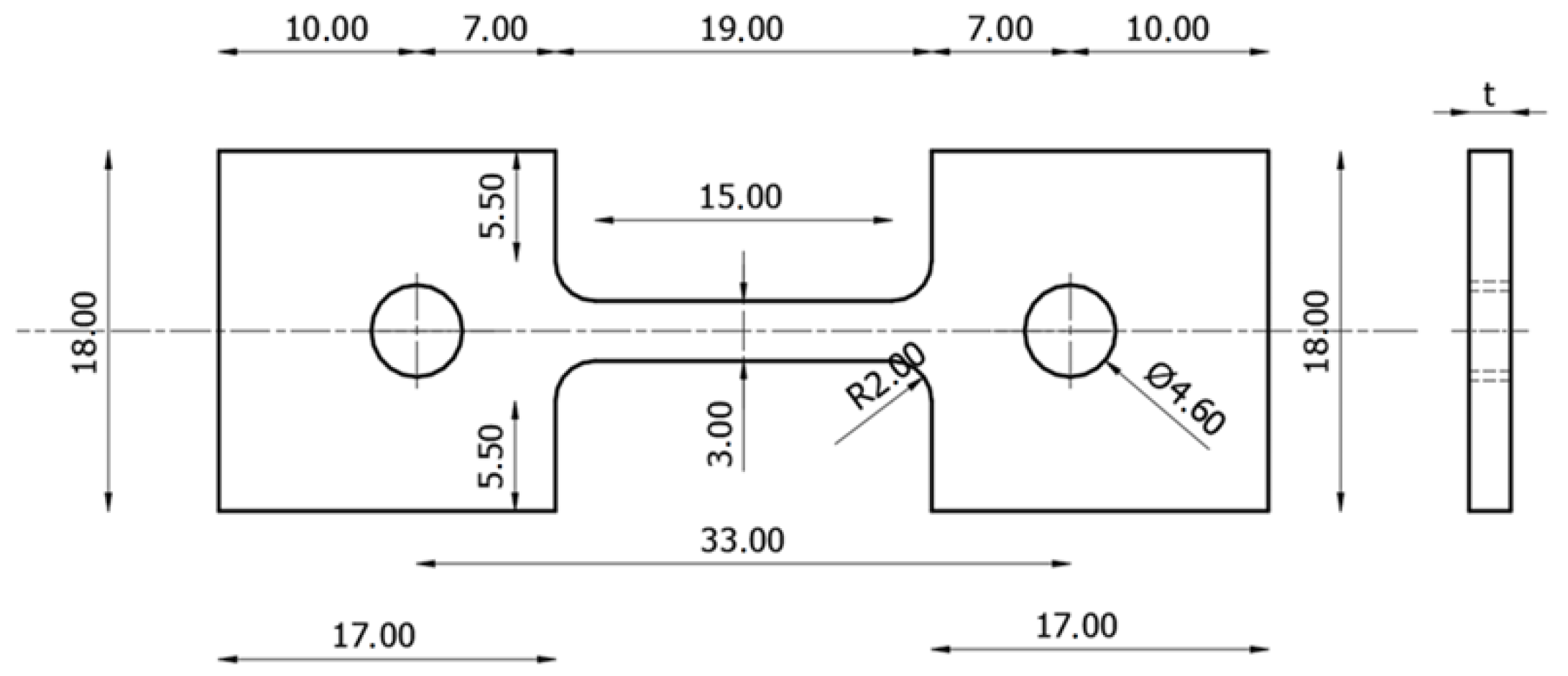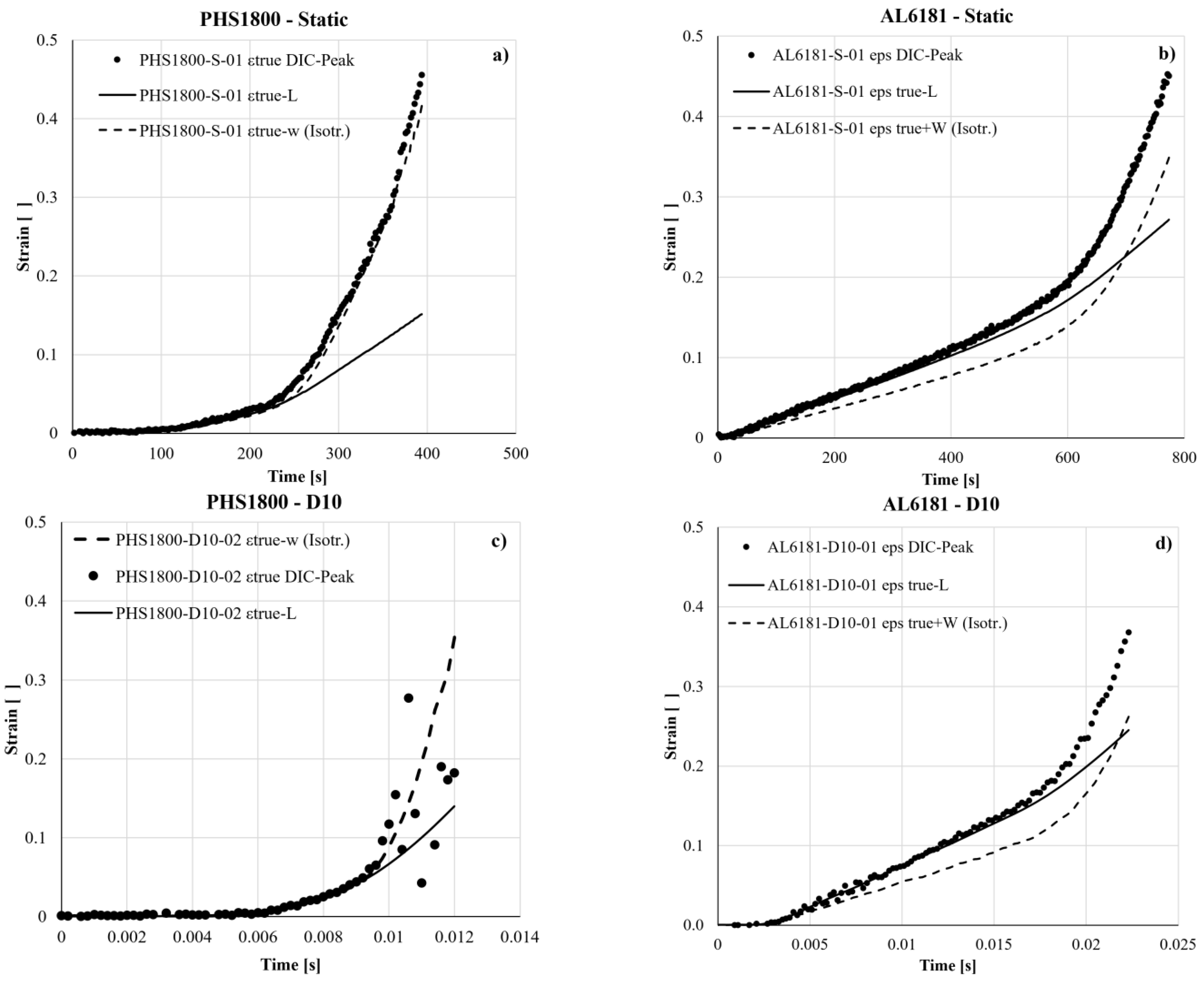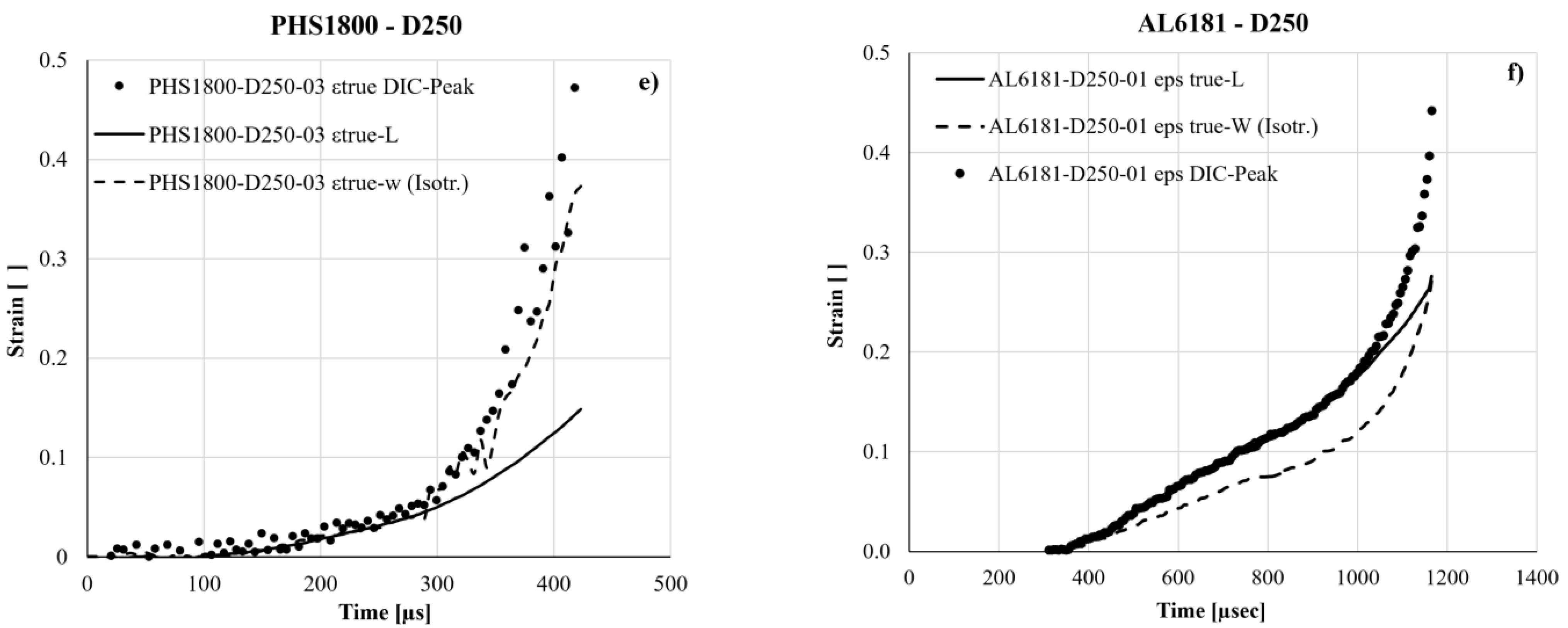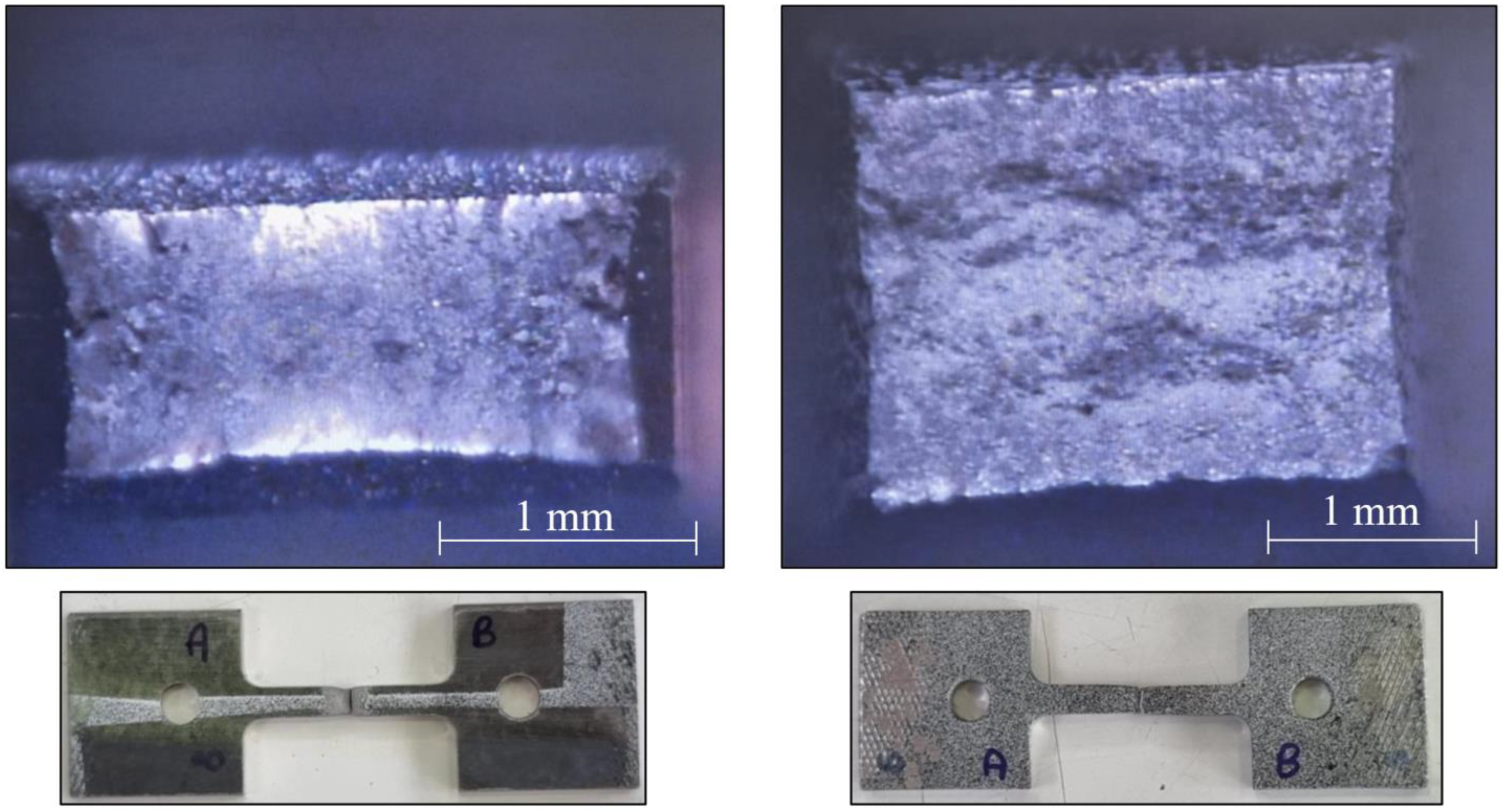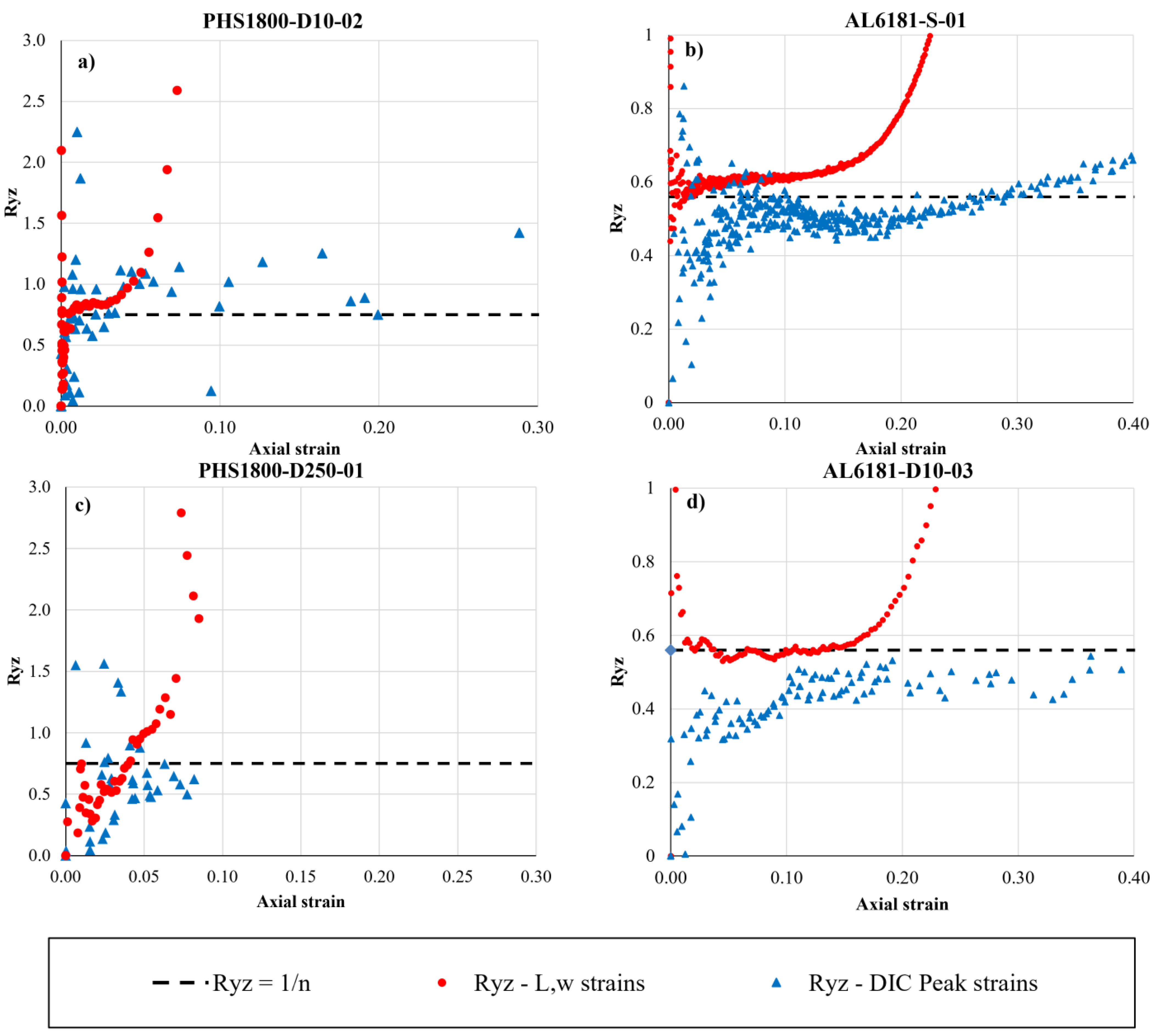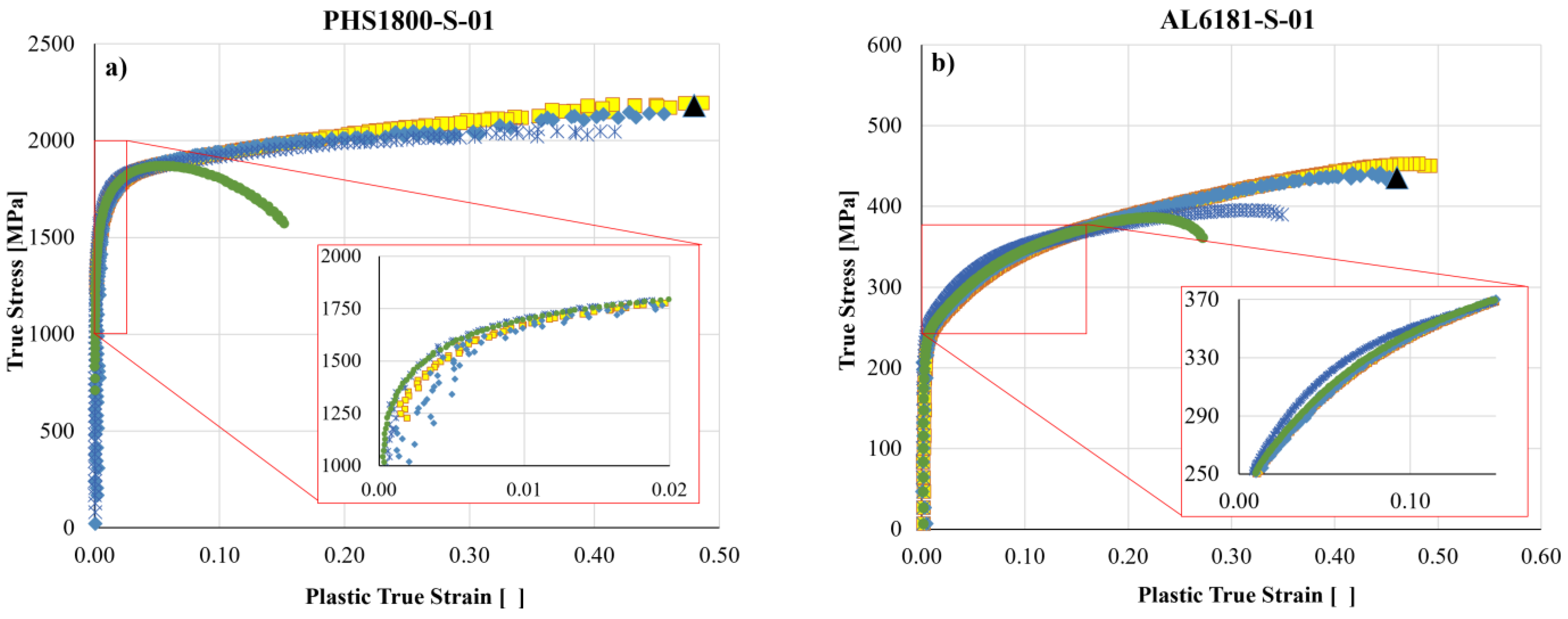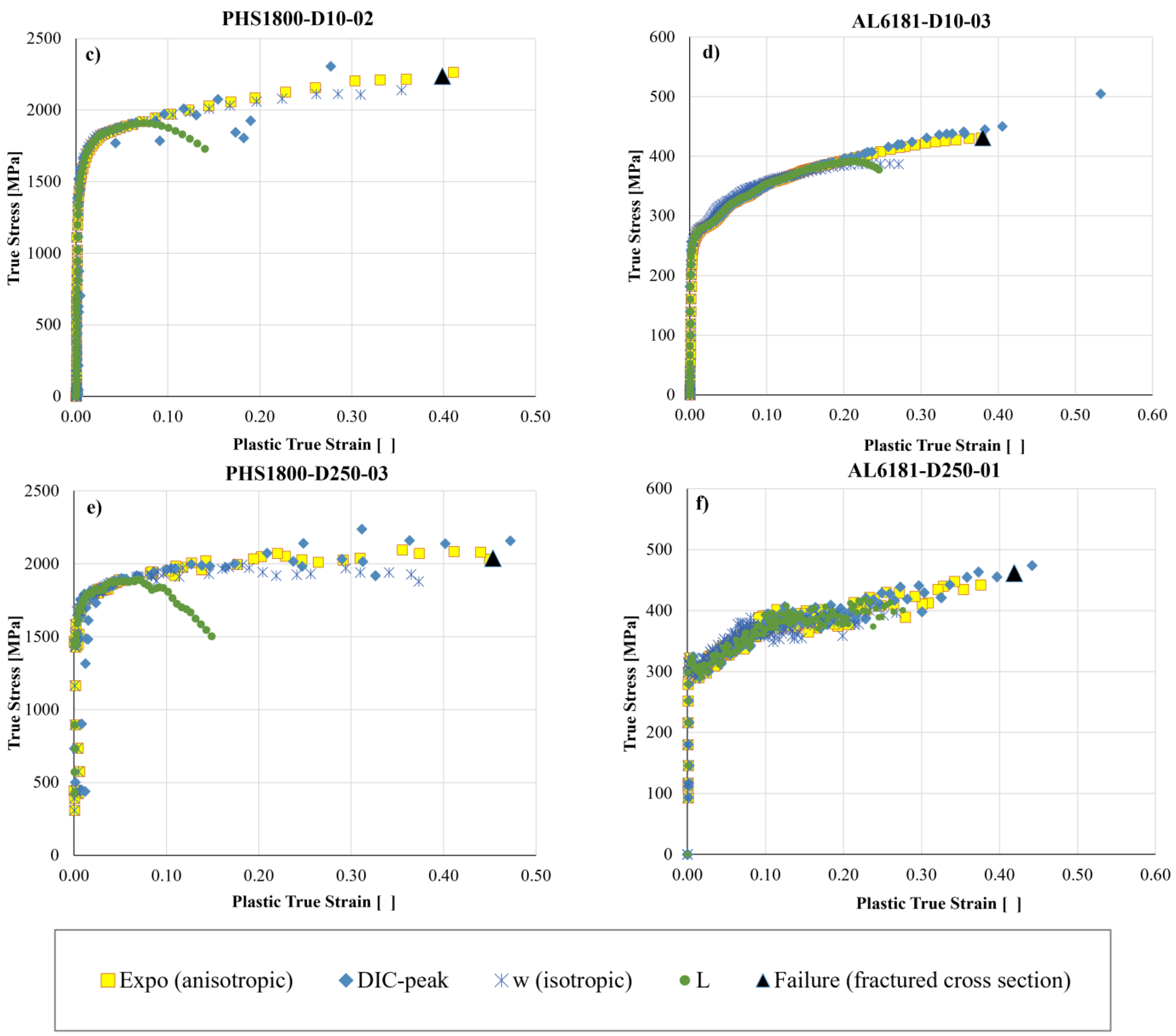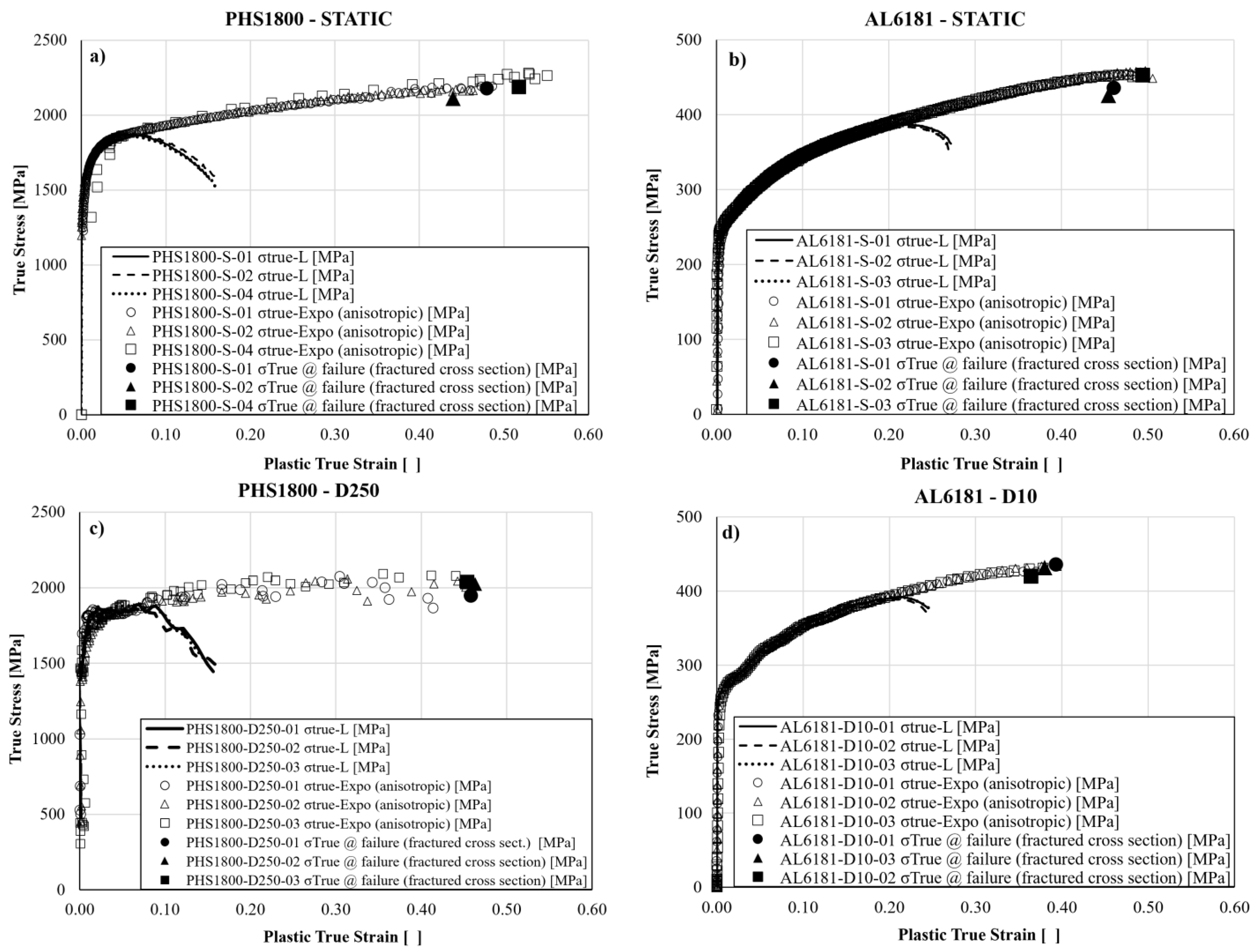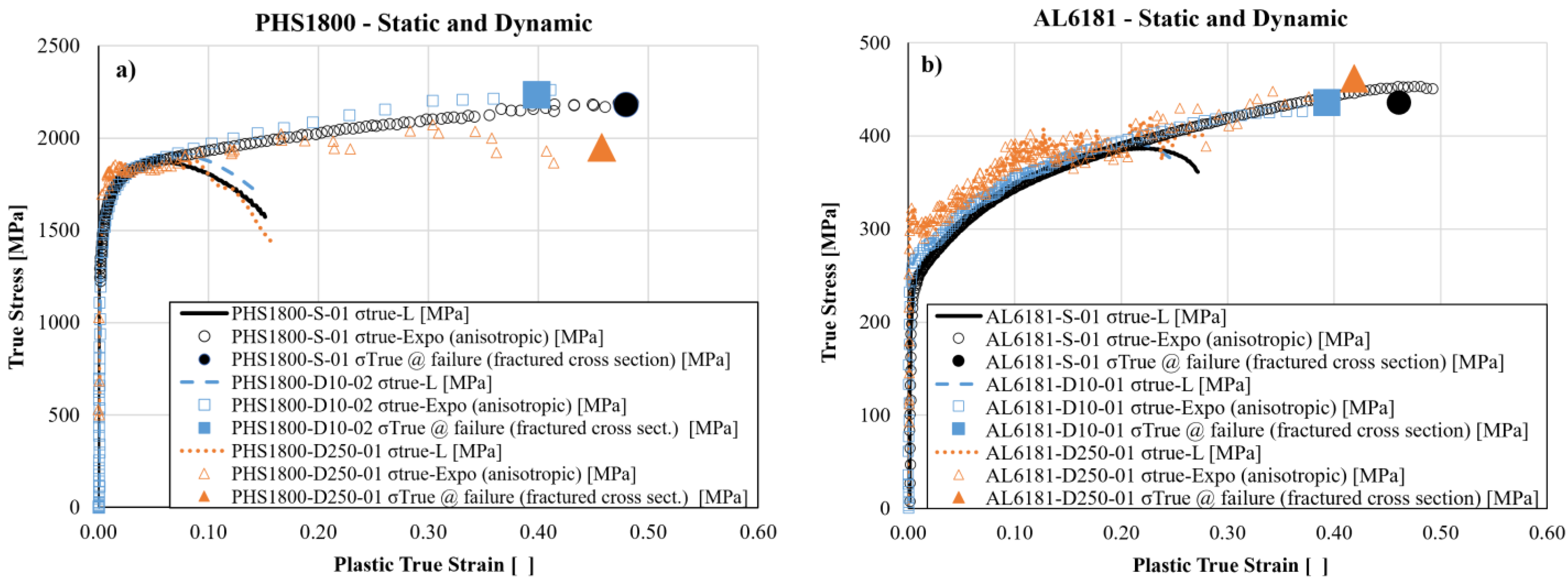This section reports the application of the above procedures to the experimental results, showing the different outcomes and comparing them to each other.
This means that the eventual anisotropy of such steel negligibly affects the equality , so that and the strain definitions of Equations (1) and (5) are coincident with each other, . Instead, the identity of strains from Equations (1), (3), and (7), , is always guaranteed before necking onset because of the stress–strain uniformity, independently of the isotropic/anisotropic response of metals.
Therefore, while the pre-necking strain history of the PHS steel is identified and validated by all three strain definitions (short strain range from 0 to 0.05), currently no reliable prediction is available over the much longer post-necking strain range (between 0.05 and 0.35 for dynamic tests, up to 0.5 for the static ones), where the effective true strain stays somewhere between the three different predictions of , and .
Before the necking onset (strains below
), the strain histories of the AL6181 alloy remarkably differ from each other (second column of
Figure 5): the strains
and
remain identical to each other because of the pre-necking strain uniformity, but
is quite lower than the former strains, which highlights a pronounced anisotropy effect. In fact, the evidence that
can be expressed as:
Before necking onset, the specimen is still a straight parallelepiped independent of the material anisotropy; then volume conservation yields:
Combining Equations (10) and (11) delivers:
The inequality in (12) proves that the Al6181 alloy exhibits plastic anisotropy and that the strains parallel to the thickness are greater than those parallel to the width. This means that
and
also correctly deliver the pre-necking true strain for anisotropic materials, while
only does so for isotropic materials.
For the alloy AL6181, the pre-necking true strain can also be accurately determined despite the anisotropy; however, so far no reliable estimate of the true strain is available in the post-necking range (from 0.12 to somewhere around 0.35). These uncertainties about the post-necking true strain also apply to the shrinking neck section and, in turn, to the related true stress.
Both metals at hand exhibit failure strains roughly around 0.45, with necking strains of 0.05 (Steel) and 0.12 (Al alloy); therefore, the above uncertainties about the true curve respectively apply over nearly 90% and 75% of the material life.
4.1. Neck Section of Flat Anisotropic Specimens
The trend of the thickness reduction,
, is estimated by the volume conservation according to Equation (13), which is only valid in the pre-necking phase because the specimen shape still remains a straight parallelepiped:
Over the post-necking phase of a test, Equation (13) stops delivering accurate evaluations of the ratio
because the shape of the specimen progressively assumes the typical hourglass-like aspect. However, the ratios at failure
and
are obtained in this work by image analysis of the fractured specimens, as visible in
Figure 7 for two representative tests.
Figure 8 reports the experimental values of
plotted against the width reduction ratio
, for representative tests of each material sheet: the pre-necking data from Equation (13) are reported as a dense scatter of circular points and the post-necking values (where Equation (13) stops being valid) are reported, for completeness, as the dashed curves. Data at failure are identified by triangular points.
The initial undeformed state of the specimen corresponds to the point of coordinates (1;1); as the test proceeds, the cross section shrinks and the successive points of the trend move backward.
The valid data of
vs.
consisting of the pre-necking range together with the isolated points at failure, are found to very closely follow a power law according to Equation (14), plotted as the blue continuous curves in
Figure 8, with best-fit exponents
n = 1.35 for the PHS steel and
n = 1.8 for the Al alloy.
After the necking onset, Equation (13) stops delivering reliable estimates, so the resulting trends quickly change their path and the dashed curves bifurcate from the respective power laws. The black continuous curves in
Figure 8 refer to the case of perfect isotropy where
, so that the function of Equation (14) degenerates into an identity function and its plot becomes a straight 45 degree segment.
The exponents,
n, of the approximating functions in
Figure 8 also exhibit the important feature of expressing the ratio of strain along the thickness/strain along the width, also known as Lankford coefficient
Ryz or
Rzy. Applying the logarithm to both sides of Equation (14), before necking onset yields:
Figure 8 indicates that if the power trend of Equation (14) adequately describes the relationship between thickness and width of anisotropic specimens before necking and at failure, its estimate is also reliable all over the post-necking strain range. This means that the proposed procedure can deliver the shrinking cross section of anisotropic tensile specimens from simple optical measurements of the specimen width and length, possibly supported, for further validation, by width–thickness measurements on the fractured specimens.
It is also demonstrated now that if the Lankford coefficient is evaluated directly from the strains, instead of being derived as the exponent of the best-fitting curve of vs. , accuracy issues arise, especially in case of early necking materials, because of the intrinsically indetermined ratio between plastic strains tending to zero at the beginning of the plastic range.
Figure 9 compares the Lankford coefficient
from four representative experiments according to Equation (16) against the estimate
discussed before:
with
calculated once by the
L-based and
w-based strains, then by
DIC-Peak strains along
x and
y directions.
The trends of
for the PHS1800 steel (
Figure 9a,c) are scattered and poorly readable during the short phase of uniform-straining of the tests because of the early necking of the material. In fact, at true strain levels within 0.05, an acceptable engineering resolution of 0.005 in the measurement of strains delivers an uncertainty in excess of ±50% over a reference value
of isotropic materials. Such intrinsic unsteadiness of
worsen at lower plastic strains and tends to an indeterminate form 0/0 at first yield.
After necking onset, the
DIC-Peak-
based Lankford coefficient of the PHS1800 steel continues oscillating without delivering a distinct trend (
Figure 9a) or is interrupted prematurely because of the deteriorating/detaching speckle discussed before (
Figure 9c). Instead, the Lankford coefficient based on
L and
w after necking quickly diverges up to unrealistic values because the
L-based definition greatly underestimates the axial strain while the
w-based definition acceptably estimates the transverse strain, which obviously affects the outcome of Equation (16).
In the pre-necking phase of the AL6181 alloy (
Figure 9b,d), the Lankford coefficient predicted by the
L-w approach is higher than that based on the
DIC-Peak strains; after necking onset, the latter trend of
Ryz remains almost constant, although remarkably dispersed. Instead, the former trend rapidly diverges due to the underestimation of the
L-based axial strain mentioned above.
The estimates of
Ryz based on the power-function fit of Equation (15) are also reported as dashed lines in
Figure 9. For the early-necking PHS steel, such an estimate is the only option because the
DIC-Peak and the
L-w options do not convey useful information. For the later-necking Al alloy, the power law estimate allows us to improve and prolong the moderately accurate predictions of the pre-necking
L-w approach beyond necking onset.
4.2. True Curve of Flat Anisotropic Specimens
The extrapolation of
after necking onset by way of Equation (14) also allows us to derive the evolution of the neck section accounting for the anisotropic response, as:
Then the post-necking true stress-true strain curves, based on the specimen width, can be improved accounting for the anisotropic response. Taking into account Equations (14) and (17), the true stress and true strain defined in Equations (1) and (2) become:
It is worth noting that for
n = 1, Equations (18) and (19) degenerate into Equations (5) and (6) for the
w-based true data of isotropic materials.
The true curves derived by the four procedures discussed so far, namely:
L-based, W-based, DIC-based and
Exponent-based (according to Equations (18) and (19)); are compared to each other in
Figure 10 for a selection of representative tests.
Until necking onset, the
L-based,
DIC-
based and
Exponent-based true curves of
Figure 10 are obviously coincident with each other. The
w-based true curves slightly differ from the above three curves because of the neglected anisotropy in estimating cross section (see magnified plots for the static tests).
Over the post-necking phase, the various procedures deliver rather different responses. The L-based true curves obviously stop delivering useful information and quickly fail, independently of the material considered, because the strain based on the gage elongation completely fails to estimate the strain localization due to necking: the L-based estimate of the true strain at failure is 0.15 while the effective value is around 0.45.
The
w-based true curves, which in the case of isotropic metals are the most accurate and very simple to determine, rely on the aspect ratio of the cross section remaining constant during the test, which contrasts with the anisotropic response. In fact, such curves are slightly inaccurate for the PHS1800 steel which only exhibits moderate anisotropy (
w-based failure strains in
Figure 10a,c,e are underestimated slightly more than 10%), but are largely underestimating the post-necking stresses and strains for the AL6181 alloy which exhibits a more pronounced anisotropy (
w-based failure strains in
Figure 10b,d,f are underestimated of more than 30%).
The dynamic
DIC-based true curves of the PHS steel are slightly scattered (
Figure 10e) or interrupted before failure (
Figure 10c) because the deteriorating surface of the metal causes the painted speckles to detach and spoils the strain measurements. By contrast, the
DIC-based true curves of the Al alloy (
Figure 10b,d,f) are steady and continuous up to failure, eventually overestimating the failure strain (
Figure 10d). The scatter band, only visible in the true curves of the aluminium at 250 s
−1 (
Figure 10d), is due to electrical noise disturbing the load acquisition during those tests (it also appears in the L-
based curve).
The
DIC-
based true curves are intrinsically affected by difference between the local peak strain on the specimen surface and the effective section-averaged true strain, as depicted in
Figure 2. However, all the
DIC-based true curves in
Figure 10 pass rather close to those of the failure points from measurements on the broken specimens, meaning that for the given alloys and specimen geometries, the error introduced by the above difference is quite small.
This confirms that despite that the error intrinsic in the
DIC-based procedure is not predictable or controllable a priori, small-sized metal sheet specimens with low aspect ratio w/t (2 for the PHS steel and 1.5 for the Al alloy), allow us to obtain reasonable accuracy with the procedure at hand. Relatively thinner specimens, such as those prescribed by the usual regulations (
exceeding 10), would certainly deliver overestimated
DIC-based true curves, with the typical upward convexity as in [
6].
The
Exponent-
based true curves in
Figure 10, obtained by proposed Equations (18) and (19), exhibit steady undispersed trends, for all tests of both metals, and are the only ones unaffected by any conceptual error/approximation throughout the post-necking range, independently of the material hardening/necking/anisotropy (PHS1800 and AL6181 alloys greatly differ from each other in all these viewpoints), and regardless of the width/thickness ratio of the specimen (ranging from 2 to 3 for our experimental campaign).
The only inference delivering the Exponent-based procedure was that the trend of vs. over the post-necking phase follows the same power function, which appropriately describes such experimental relationship before necking and at failure. This is a natural deduction rather than an assumption or hypothesis; therefore, these curves are the most intrinsically accurate ones among those considered and are taken as the reference curves in the next considerations.
Then, the Exponent-based true curves proposed in this work as and advancement for the stress/strain characterization of anisotropic sheet metals, are compared ahead to the standard true curves relying on the L-based procedure, for all the static/dynamic tests of the experimental campaign at hand.
Given that three identical repetitions were run for each material and each strain rate, an assessment of the test repeatability is made in
Figure 11 by reporting the true curves from representative static and D250 experiments on the PHS1800 steel, and static and D10 experiments on the AL6181 alloy.
Despite the deterioration of the DIC speckle on the PHS steel affected the optical measurements, the corresponding true curves in
Figure 11 are quite close to each other; whereas those of the AL6181 alloy are fully overlapped. Thanks to the overall test repeatability evidenced in
Figure 11, the data from a single test are taken as representative of the entire corresponding series of three identical test repetitions. Then the
L-
based and the
Exponent-
based true curves from all test series are plotted together in
Figure 12 for each material in order to assess the differences between the two approaches at the static and dynamic rates investigated.
The overview in
Figure 12 for all the test series confirms the outcomes of the previous representative tests. In fact, the proposed
Exponent-based true curves fully overlap the classical
L-based true curves within the necking onset, where both curve series are not affected by any formal/conceptual approximation. Afterward, the
Exponent-based curves continue delivering their prediction over the entire post-necking range, simply
based on extending the pre-necking trend of the anisotropic deformation and on the thickness/width measurements on the failed cross sections, while the
L-based curves fail to convey further realistic stress-strain data.
The true curves of the AL6181-D250 tests exhibit more scatter than other curves, including those of the similar D250 tests made on the PHS steel, because of noise from the electrical network affecting the acquired load signal in the SHTB; in fact, the strain measurements of such AL6181-D250 test, as seen in
Figure 5, are as smooth and unscattered as those from other tests.
The Exponent-based procedure does not incorporate any conceptual approximation as the L-based procedure does (neglecting the whole necking effect), as the w-based procedure does (neglecting the anisotropic shrinking of the neck section), and as the DIC-based procedure does (neglecting the unpredictable differences between local strain readings and section-averaged true strains which depend on the specimen aspect ratio and on the material hardening).
Summarizing, the Exponent-based procedure proposed here for deriving the neck evolution and the post-necking true curve is the main outcome of the paper. It has the merit of removing some conceptual inaccuracies intrinsic in the other procedures and of easily delivering the true curves of anisotropic sheet metals extended throughout the post-necking range up to failure, together with a steady robust estimate of the anisotropy Lankford coefficient unaffected by the numerical noise at low plastic strains.
In fact, both post-necking true curves and Lankford coefficients are quite difficult to determine with other means when anisotropic materials exhibit early necking onset and remarkable ductility, such as the alloys considered here (the pre-necking range just covers around 10% of the straining life for the PHS1800 steel and 25% for the AL6181 alloy).
Finally, it is necessary to recall that the true curves of elastoplastic materials are not yet the flow curves expressing their plastic hardening because after necking onset, the former curves include triaxiality contributions which should be corrected (e.g., [
18,
20]) in order to deliver the latter curves. Furthermore, to model the two materials at hand by finite elements analyses, their anisotropy should also be assessed and modelled, first by repeating the experimental campaign we have discussed so far with specimens machined along other directions, and then by selecting and calibrating a suitable anisotropy model (e.g., refs. [
29,
30]) to describe the experimental anisotropy.
Both such aspects lie beyond the scopes of the present work, the goal of which was to assess and possibly remove the conceptual approximations of the usual procedures to calculate the true-stress–true-strain curves and the Lankford coefficients from tensile tests on flat specimens of anisotropic metals.

